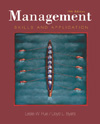 |  Management: Skills and Application, 10/e Leslie W Rue,
Georgia State University - Emeritus
Lloyd L Byars,
Georgia Institute of Technology
Motivating Employees
Chapter Summary| 1. Define motivation. Motivation is concerned with what activates human behavior, what directs this behavior toward a particular goal, and how this behavior is sustained.
2. Describe the scientific management approach to motivation. The scientific management approach to motivation is based on the assumption that money is the primary motivation of people: if the monetary reward is great enough, employees will work harder and produce more.
3. Explain the equity approach to motivation. The equity approach of motivation is based on the idea that people want to be treated fairly in relationship to others.
4. Explain the hierarchy of needs. The five levels of needs are physiological, safety, social, ego, and self-actualization. The physiological needs include food, sleep, water, exercise, clothing, and shelter. Safety needs are concerned with protection against danger, threat, or deprivation. Social needs are the needs for love, affection, and belonging. Ego needs include both self-esteem and the esteem of others. Self-actualization is the need of people to reach their full potential in applying their abilities and interests to functioning in their environment.
5. Discuss the achievement-power-affiliation approach to motivation. This approach focuses on three needs of people: achievement, power, and affiliation. The level of intensity of these needs varies among individuals, and people are motivated in situations that allow them to satisfy their most intense needs.
6. Discuss the motivation-maintenance approach to motivation. This approach postulates that all work-related factors can be grouped into two categories. The first category, maintenance factors, will not produce motivation but can prevent it. The second category, motivators, encourages motivation.
7. Discuss the expectancy approach to motivation. This approach holds that motivation is based on a combination of the individual's expectancy that increased effort will lead to increased performance, the expectancy that increased performance will lead to increased rewards, and the individual's preference for those rewards.
8. Explain the reinforcement approach to motivation. This approach is based on the idea that behavior that appears to lead to a positive consequence tends to be repeated, while behavior that appears to lead to a negative consequence tends not to be repeated.
9. Define job satisfaction and organizational morale. Job satisfaction is an individual's general attitude about his or her job. Organizational morale refers to an individual's feeling of being accepted by, and belonging to, a group of employees through common goals, confidence in the desirability of these goals, and progress toward these goals. |
|



 2003 McGraw-Hill Higher Education
2003 McGraw-Hill Higher Education